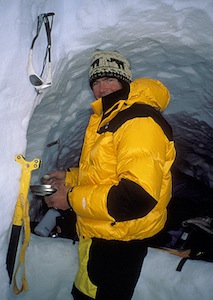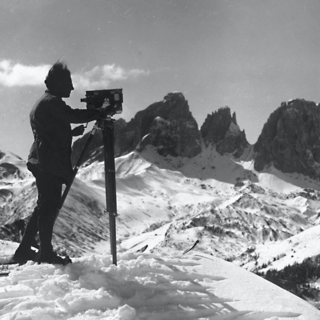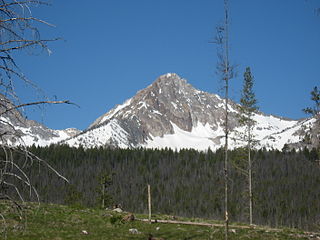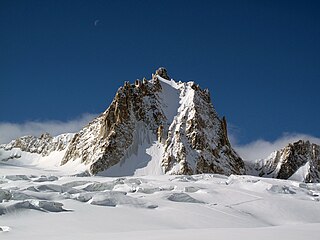
Alpine skiing, or downhill skiing, is the pastime of sliding down snow-covered slopes on skis with fixed-heel bindings, unlike other types of skiing, which use skis with free-heel bindings. Whether for recreation or for sport, it is typically practiced at ski resorts, which provide such services as ski lifts, artificial snow making, snow grooming, restaurants, and ski patrol.

A ski resort is a resort developed for skiing, snowboarding, and other winter sports. In Europe, most ski resorts are towns or villages in or adjacent to a ski area – a mountainous area with pistes and a ski lift system. In North America, it is more common for ski areas to exist well away from towns, so ski resorts usually are destination resorts, often purpose-built and self-contained, where skiing is the main activity.

Aspen Highlands is a skiing mountain in Aspen, Colorado. It is famous for the Highland Bowl, which provides what some people consider some of the most intense, wild, and fun skiing in the state. The Aspen Skiing Company operates Aspen Highlands.

La Grave is a commune in the Hautes-Alpes department in southeastern France.

Stewart Alexander Lowe was an American mountaineer. He has been described as inspiring "...a whole generation of climbers and explorers with his uncontainable enthusiasm, legendary training routines, and significant ascents of rock climbs, ice climbs, and mountains all over the world...". He died in an avalanche on Shishapangma, in Tibet. The Alex Lowe Charitable Foundation honors his legacy.

Kicking Horse Mountain Resort (KHMR) is a ski resort located 6.4 kilometres (4.0 mi) west of Golden, British Columbia, Canada. It features over 120 trails across more than 3,486 acres (14.11 km2) of skiable terrain and a 1,315-metre (4,314 ft) vertical drop, currently the sixth largest of any North American ski resort. The resort, named after the nearby Kicking Horse River and Kicking Horse Pass, spans the easternmost slope of the Purcell Mountains overlooking the Rocky Mountain Trench. It is located roughly 7 kilometres (4 mi) east of Glacier National Park and 23 kilometres (14 mi) west of Yoho National Park.

Jackson Hole Mountain Resort (JHMR) is a ski resort in the western United States, at Teton Village, Wyoming. In the Teton Range of the Rocky Mountains, it is located in Teton County, twelve miles (20 km) northwest of Jackson and due south of Grand Teton National Park.
Doug Coombs was an American alpine skier and mountaineer who helped to pioneer the sport of extreme skiing, both in North America and worldwide.

Montage Mountain is a ski area in Pennsylvania that is located 8 miles (13 km) from downtown Scranton, Pennsylvania. Situated roughly 125 miles (201 km) northwest of Philadelphia and New York City, this resort has twenty-six trails, two terrain parks, and one of Pennsylvania's longest snow tubing areas. The mountain has a summit elevation of 1,960 feet (600 m) and a vertical drop of 1,000 feet (300 m).

Temple Basin is a club skifield in Arthur's Pass, in New Zealand's South Island. Operated by two clubs, the Temple Basin Ski Club and the Canterbury University Snow Sports Club, the ski area has 3 rope tows, two on-site lodges, two shelters and a ski school and ski shop. The tows cover an elevation range of 1326–1753 metres, for a skiable domain of 320 hectares. The field claim's to have the best big mountain and variety of terrain in New Zealand and has been highly recommended by adventure skiers on several occasions. The ski area is accessed on foot via a walking track from the Temple Basin Car Park within Arthers Pass. Temple Basin Ski Club operates a moterised goods lift to carry patrons gear and other equipment.

A ski film is a motion picture with sequences of expedition, recreation, competition, or acrobatic exhibition on snow skis. These non-fiction action sport films capture the experience of an athletic outdoor snow sporting culture. Ski films typically present one or more techniques, locations, or skiers. Categories include the feature, documentary of competition or other event coverage, instruction or technique demonstration, retrospective history, travel guide showcasing a region, or a short subject. More than 200 such videos debuted in 2006. Notable examples are listed at the Ski and Snowboard Film Institute, or have received awards from the International Ski Film Festival, X-Dance Action Sports Film Festival, IF3 International Freeski Film Festival, Cold Smoke Winter Film, Powder magazine, or similar.

Powder King Mountain Resort, commonly referred to simply as Powder King, is located in the Pine Pass area of the Northern Rockies of British Columbia's Northeastern Interior. It is the only year-round destination alpine resort in North America found alongside a major route. Ranked #4 in all of North America for snow, the area boasts the best snow quality of all Canadian ski hills.

Sylvain Saudan is an extreme skier, dubbed "skier of the impossible." He is noted for skiing down large and steep mountains, including those in the Himalayas, North America, Asia, Africa and Europe. In 1982, he entered the Guinness Book of World Records for conquering the highest most steepest slope ever skied.

Williams Peak, at 10,636 feet (3,242 m) high is the 6th highest peak in the Sawtooth Mountains of Idaho and is located within the Sawtooth Wilderness portion of the Sawtooth National Recreation Area. The peak lies 0.75 mi (1,210 m) north-northeast of Thompson Peak, the highest peak in the range.
Silverton Mountain is a ski area near Silverton, Colorado, United States that opened on January 19, 2002. Popular with skiers and snowboarders, Silverton Mountain has one chairlift that carries visitors into its terrain, which is for advanced and expert skiers or riders. Avalanche gear is required to ride the lift at all times due to the unpatrolled and ungroomed nature of Silverton. In addition to Silverton Mountain's 1,819 acres of lift accessed skiing, Silverton also serves as a base area for over 22,000 acres of helicopter accessed skiing. Uniquely, Silverton is only open Thursday through Sunday from December through April.
Karl Fostvedt is an American Freeskier from Ketchum, Idaho. He is sponsored by Dakine, K2 Sports, Anon Optics, Lethal Descent, Full Tilt Boots. He is known for his urban, backcountry, and big mountain skiing abilities.

The Tour Ronde is a mountain in the Mont Blanc massif of the Alps, situated on the border between France and Italy. It is a prominent mountain, some 3.5 km north-east of Mont Blanc, but is effectively part of a continuation of the south eastern spur of Mont Maudit which forms a frontier ridge between the two countries. It is easily accessible to mountaineers and provides not only a very good viewpoint from its summit of the Brenva face and the major peaks on the southern side of Mont Blanc, but it also offers a popular introduction to alpine climbing of all grades, including a north face ascent.
"Sick" Rick Armstrong is a professional skier, freeskiing pioneer, mountaineer, paraglider, businessman and serial entrepreneur based in Jackson Hole, Wyoming. He was a pioneering guide in the early years of Alaska Heli-skiing while working as a lead guide for Valdez Heli-skiing and Doug Coombs as chronicled in the 2007 feature film Steep. He was a member of the ultra-elite group of skiers called the Jackson Hole Airforce who transformed skiing in the 1990s and 2000s. He is known for having skied unskied lines such as his first and unrepeated massive drop into the left side of the notorious Corbet's Couloir at Jackson Hole Mountain Resort. He was the first person to have both skied and snowboarded the Grand Teton in Teton National Park. He has many first ski descents in China, Alaska, Europe, Antarctica, South America, and South Georgia Island. He was an athlete in the 1998 and 1999 Winter X-Games in Crested Butte. He was Awarded sponsorships by The North Face and Salomon. He also became an athlete talent scout for The North Face building a world-class ski team by discovering soon to be ski stars such as Sage-Cattabriga-Alosa, Ingrid Backstrom, Kitt Deslauries, Griffen Post, and Hillary Nelson. Armstrong was also a co-founder of the Teton Gravity Research film production company. He served on the board of directors for Intrawest from 2012 to 2017.
This glossary of skiing and snowboarding terms is a list of definitions of terms and jargon used in skiing, snowboarding, and related winter sports.
Barry Corbet was an American mountaineer, film maker and an author. He was a member of the first U.S. Team to climb Mt. Everest. Corbet produced or co-produced more than 100 films and was editor of New Mobility, a magazine on disability culture and lifestyle. He wrote extensively on disability related issues. His book, Options: Spinal Cord Injury and the Future, was published in 1980.














